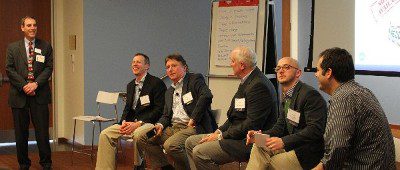
Is there really a better way to deliver fast track projects?
A panel of biopharmaceutical company and A/E/C industry
The simple answer is yes—if you create a culture of collaboration.
But just how is that accomplished?
Well, each panelist offered practical, actionable advice for implementing that solution, including:
- Project charter: Formally define what “success” means by creating and adhering to a “project charter” at the project onset. The charter should make clear what the project’s goals are so the team fully understands what outcome are expected for the project to achieve success.
- Upfront planning: Take appropriate time at the beginning of a project to properly plan all activities and milestones before any execution occurs. “Before we go fast, we have to go slow,” remarked Richard Quinby, Associate Director of Global Project Engineering at Biogen.
- Full team engagement: Assemble the entire team at the beginning of the process, including disciplines that typically are involved at later stages (eg, construction and CQV). Be sure to include local governments (eg, for permitting issues) early also.
- Defined roles and responsibilities: Assigning titles does not work. Clearly define the responsibilities of every role on the project so no ambiguity exists about what is expected from each person. Sanofi’s North America Capex Procurement Director, Tony Mejido, commented, “You cannot over-communicate the expectations for any role.”
- Permanent team: To ensure consistency and perspective, the same individuals providing the same voice are required to participate from project beginning to end. Eric Felz, Associate Director of Validation at Shire, cautioned “If the same people are not onsite all the time, you will never achieve continuity.”
- Collective team buy-in: Acknowledge that most team members have their “day job” to work on as the project proceeds. Nevertheless, they must understand that to effectively participate, they must be committed and take accountability for their assigned role at every step in the process.
- Team co-location: The entire team must be geographically placed in one location. Electronic meetings and communications are not as effective as physically siting a group together, which promotes optimal communication, collaboration, and issue resolution. Cory Siddons, DPS Senior Project Manager, reflected that “The most successful fast track projects I have worked on involved the entire team working from one spot.”
- Strong project management: A highly capable project manager is critical for consistently keeping a schedule on track, maintaining open communication lines, handling personality conflicts, and keeping all stakeholders focused on project objectives and moving forward.
- Appropriate tools: Establish reliable collaboration methods and then develop the necessary tools, including project execution plan, integrated project schedule, schedule risk analysis, and building information model (BIM). Indeed, Jim Busam, Vice President, National Client Team, at Gilbane Building Company, noted that “Every successful project today must have a strong BIM—it serves as the backbone of the project.”
Finally, the most important requirement for generating an environment that produces a successful fast track project is owner commitment. A fast track project only succeeds when an owner is fully invested in the above practices and objectives. The owner is the pivotal contributor to establishing the right tone, promoting teamwork, and creating that culture of collaboration.
Pictured above from left:
Moderator: Jack Campion (The Hart Companies).
Roundtable panelists: Richard Quinby (Biogen); Tony Mejido (Sanofi); Jim Busam (Gilbane Building Company); Cory Siddons (DPS); and Eric Felz (Shire).
